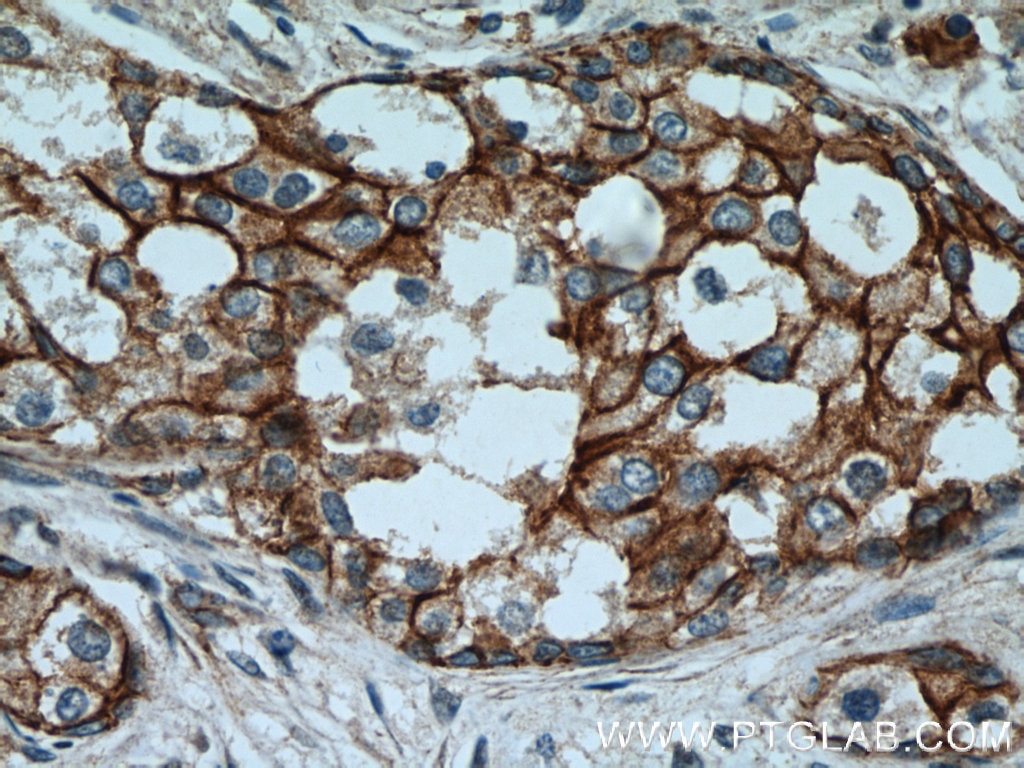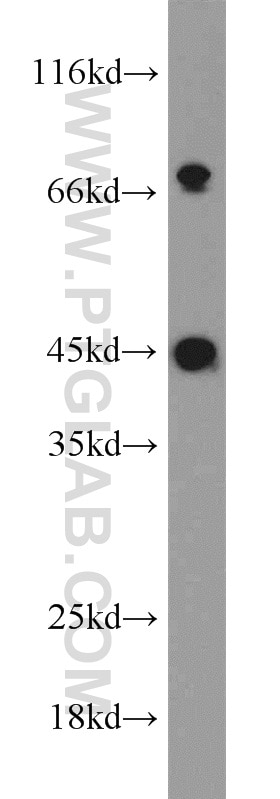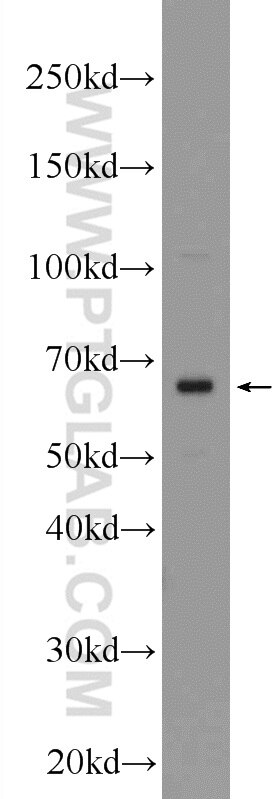- Featured Product
- KD/KO Validated
WNT5A/B Polyclonal antibody
WNT5A/B Polyclonal Antibody for WB, IHC, ELISA
Host / Isotype
Rabbit / IgG
Reactivity
human, mouse and More (3)
Applications
WB, IHC, IF, IP, RIP, ELISA
Conjugate
Unconjugated
Cat no : 55184-1-AP
Synonyms
Validation Data Gallery
Tested Applications
| Positive WB detected in | mouse heart tissue, HUVEC cells, PC-3 cells |
| Positive IHC detected in | human lung cancer tissue, human tonsillitis tissue, human thyroid cancer tissue Note: suggested antigen retrieval with TE buffer pH 9.0; (*) Alternatively, antigen retrieval may be performed with citrate buffer pH 6.0 |
Recommended dilution
| Application | Dilution |
|---|---|
| Western Blot (WB) | WB : 1:500-1:3000 |
| Immunohistochemistry (IHC) | IHC : 1:50-1:500 |
| It is recommended that this reagent should be titrated in each testing system to obtain optimal results. | |
| Sample-dependent, Check data in validation data gallery. | |
Published Applications
| KD/KO | See 2 publications below |
| WB | See 42 publications below |
| IHC | See 8 publications below |
| IF | See 13 publications below |
| IP | See 1 publications below |
| RIP | See 1 publications below |
Product Information
55184-1-AP targets WNT5A/B in WB, IHC, IF, IP, RIP, ELISA applications and shows reactivity with human, mouse samples.
| Tested Reactivity | human, mouse |
| Cited Reactivity | human, mouse, rat, chicken, zebrafish |
| Host / Isotype | Rabbit / IgG |
| Class | Polyclonal |
| Type | Antibody |
| Immunogen | Peptide |
| Full Name | wingless-type MMTV integration site family, member 5A |
| Calculated Molecular Weight | 42 kDa |
| Observed Molecular Weight | 38 kDa |
| GenBank Accession Number | NM_003392 |
| Gene Symbol | WNT5A |
| Gene ID (NCBI) | 7474 |
| RRID | AB_2881285 |
| Conjugate | Unconjugated |
| Form | Liquid |
| Purification Method | Antigen affinity purification |
| Storage Buffer | PBS with 0.02% sodium azide and 50% glycerol pH 7.3. |
| Storage Conditions | Store at -20°C. Stable for one year after shipment. Aliquoting is unnecessary for -20oC storage. 20ul sizes contain 0.1% BSA. |
Background Information
The WNT gene family consists of structurally related genes which encode secreted signaling proteins. There are 19 Wnt genes in the human genome that encode functionally distinct Wnt proteins. These proteins have been implicated in oncogenesis and in several developmental processes, including regulation of cell fate and patterning during embryogenesis. Wnt members bind to the Frizzled family of seven-pass transmembrane proteins and activate several signaling pathway. Wnt5A is a member of the Wnt family of proteins, which are 38-45 kDa secreted cysteine-rich proteins with hydrophobic signal peptides. This antibody can recognize WNT5A and WNT5B.
Protocols
| Product Specific Protocols | |
|---|---|
| WB protocol for WNT5A/B antibody 55184-1-AP | Download protocol |
| IHC protocol for WNT5A/B antibody 55184-1-AP | Download protocol |
| Standard Protocols | |
|---|---|
| Click here to view our Standard Protocols |
Publications
| Species | Application | Title |
|---|---|---|
Cell Metab Mitochondrial Dynamics Is Critical for the Full Pluripotency and Embryonic Developmental Potential of Pluripotent Stem Cells. | ||
Genome Biol Integrated genomic and transcriptomic analysis reveals unique characteristics of hepatic metastases and pro-metastatic role of complement C1q in pancreatic ductal adenocarcinoma. | ||
Acta Biomater Substrate stiffness regulates differentiation of induced pluripotent stem cells into heart valve endothelial cells. | ||
Biomaterials Osteogenesis potential of different titania nanotubes in oxidative stress microenvironment. | ||
Nanoscale An assembly-inducing PDC enabling the efficient nuclear delivery of nucleic acid for cancer stem-like cell suppression | ||
Arch Med Res RNA-binding Protein QKI Inhibits Osteogenic Differentiation Via Suppressing Wnt Pathway |
Reviews
The reviews below have been submitted by verified Proteintech customers who received an incentive for providing their feedback.
FH Darin (Verified Customer) (11-02-2017) | No signal in lung epithelial cells from mice. However, it is possible that the protein is not expressed in lung epithelial cells.
|















